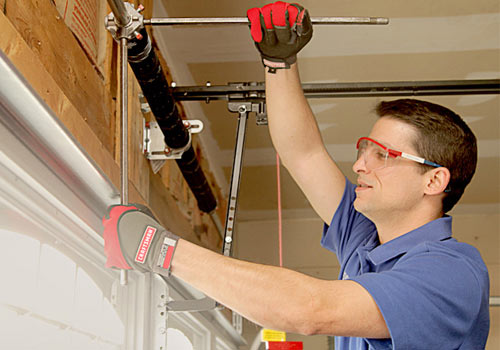Usual Garage Door Troubles and Exactly How to Deal with Them
Garage doors are important for both safety and comfort, yet they frequently provide a variety of typical problems that can irritate home owners. Troubles such as too much sound throughout procedure, doors that fall short to open up or close, misaligned tracks, and malfunctioning remotes can occur without warning. While some concerns might show up simple to fix, others might need a much more nuanced understanding of garage door auto mechanics. Attending to these issues effectively not just improves functionality but additionally lengthens the life of the door. One may wonder what actions are needed to tackle these challenges successfully.
Noisy Garage Door Procedure
A noisy garage door procedure can be a substantial source of annoyance for home owners, commonly suggesting underlying mechanical issues. Such disturbances may originate from different reasons, including damaged rollers, loosened equipment, or not enough lubrication. Determining the source of the noise is vital for effective resolution.
One usual reason for too much noise is the existence of corroded or worn-out rollers. With time, these components can wear away, resulting in grinding or squealing noises as the door moves. Routine inspection and substitute of these rollers can significantly minimize sound levels. Furthermore, loosened screws or screws in the door mechanism can produce rattling audios during procedure. Tightening up these fasteners guarantees an extra secure and quieter movement.
One more adding variable is inadequate lubrication of the door's moving parts. Applying a high-quality lubricant to the tracks, springs, and rollers can considerably lessen friction and noise. Homeowners need to execute this maintenance periodically to preserve ideal efficiency.
Lastly, the garage door opener might additionally generate noise due to its age or mechanical problems. If the sound continues in spite of dealing with other aspects, getting in touch with a professional for an extensive assessment and prospective repair service might be needed.
Door Will Not Open Up or Shut
Experiencing a garage door that will not open or close can be extremely aggravating and usually signifies a breakdown within the system. Numerous variables can add to this concern, and determining the source is crucial for reliable resolution.

Following, evaluate the security sensing units located at the base of the door. These sensing units can become misaligned or blocked by particles, avoiding the door from running correctly. Tidy the sensors with a soft cloth and guarantee they are straightened.
Additionally, the garage door's inner components ought to be examined. Concerns such as a broken springtime, damaged rollers, or a damaged opener can hinder motion. If any kind of components seem damaged, it may be a good idea to consult an expert for fixings.
Misaligned Tracks
To recognize imbalance, visually examine the tracks for gaps or irregular spacing. If you observe any discrepancies, it is critical to attend to the problem promptly - garage door service. Begin by loosening up the screws that protect the track to the wall, permitting modifications. Thoroughly touch the track back into its correct placement utilizing a rubber mallet or a comparable tool, guaranteeing it is straight and level.
Normal maintenance, including cleansing the tracks and ensuring rollers are in great problem, can avoid future imbalances. By resolving misaligned tracks quickly, you can recover the functionality of your garage door and improve its durability.
Broken Springs
Amongst the numerous components of a garage door system, broken springs are among one of the most usual issues that can substantially hamper its functionality. Garage door springs are vital for stabilizing the weight of the door, permitting smooth opening and closing. When a springtime breaks, it can cause a door that is challenging to run or, in some situations, totally inoperable.
There are two primary sorts of springtimes: torsion springtimes, which are placed over the door, and extension springtimes, found on either side. Indications of a damaged spring include a door that will not open up, a noticeable gap in the spring, or a loud noise during procedure. Trying additional info to run a garage door with a busted springtime can create more damage to the door or the opener.
Repairing busted springtimes is not a do it yourself task; it calls for specialized devices and knowledge due to the high tension entailed. It is advisable to speak with an expert specialist who can safely change the springtimes and ensure the door is properly stabilized. Normal maintenance and assessments can aid stop springtime failures and extend the life expectancy of the garage door system.
Push-button Control Issues

The first action is to examine the batteries in the remote. Change them if they are weak or dead. If the remote still falls short to run, check the garage door opener to make sure that its sensing units are clean and unobstructed. Dust, particles, or imbalance might impede the signal transmission between the remote and the opener.
Disturbance from other electronic tools can additionally hamper remote performance. Ensure that neighboring tools, such as wireless routers or cordless phones, are not causing disruptions. garage door service. If disturbance is presumed, try relocating these gadgets even more far from the garage door opener
In some instances, the remote might need to be reprogrammed. Seek advice from the producer's guidelines to reset the remote and synchronize it with the garage door opener. If all else fails and the remote proceeds to malfunction, think about speaking with a specialist specialist for a thorough examination and prospective substitute of the remote or opener.
Final Thought
Comments on “Skilled Garage Door Repair to Resolve Any Issue Quickly”